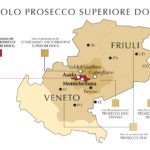The 4 Secrets of Prosecco
When I do wine tastings, I am often asked “what makes prosecco, prosecco?”
The answer stems from the way that the prosecco consortium in Italy has established the rules for creating this ever growing popular sparkling wine.
A wine must satisfy four key criteria before it can be called prosecco. Some of them have been the subject of some controversy over the last few years since the consortium created the controlled region in the northeast of Italy that has become known as the “prosecco region”.
The First Key – Origins
That in itself is the first major criteria – the wine must be made in the demarcated prosecco region of Italy. The region is 20,000 hectares in size and is found just 50 kilometres to the north of Venice wedged between the Dolomites to the north and the Adriatic to the east. It is a perilously hilly landscape with a pretty fierce topography. It gained UNESCO World Heritage status in 2017.
It’s All About The Grape
The second criteria is that the wine must be made from the grape variety called Glera. Not only must it be made from Glera, but the final product must contain at least 85% Glera based wine. Some of the best wines are 100% Glera, but there are several very fine prosecco wines that have a blend of some of the more popular white wine grapes such as Chardonnay, Pinot Grigio and Pinot Meuniere. The wines can be in either the “spumante” style or the “frizzante” style which is lighter bubbles that don’t last quite as long.
The Final Step
The third criteria that must be met is that the wine must be fermented and bottled in the region. There are a number of wines that ship huge quantities of excess juice to large bottling plants in other countries, especially Germany. They have huge bottling facilities that take wines from all over the world and bottle them very cost effectively. Any excess wines from the prosecco region sent to these plants is no longer prosecco but just regular sparkling wine.
Not Just Any Bottle
The fourth criteria – when the second fermentation is complete and the wine goes to the packaging stage, it must go into glass bottles. They may range in size from the classic 750ml “bowling pin” style through to the 3 litre double magnum. I’ve not seen them larger. This has been the source of some controversy in the past. Some entrepreneurs eager to cash in on the prosecco craze started converting small vehicles like the three-wheel Piaggio into prosecco vans. These offered sparkling wine on tap fed from a keg, claiming to be prosecco. The consortium quickly put a stop to this when it discovered the wine they were serving neither came from the prosecco region nor was it stored in glass bottle ware.
Prosecco is quite a phenomenon. No other wine in recent times seems to have reached the levels of popularity and the demand, as quickly as prosecco. How long it will last no one knows, but the market thirst for this fine and delicate bubbly is showing no signs of slowing down – yet.
© Colucci’s Copyright 2025. All rights reserved. Website by Digity.
Safe & Secure Payments by Paypal: 
